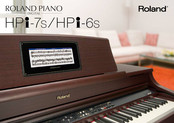Roland HPI-7S Manuals
Manuals and User Guides for Roland HPI-7S. We have 2 Roland HPI-7S manuals available for free PDF download: Owner's Manual, Specification
Roland HPI-7S Owner's Manual (136 pages)
Roland Digital Piano Owner's Manual Model HPi-7S
Brand: Roland
|
Category: Musical Instrument
|
Size: 7 MB
Table of Contents
Advertisement
Roland HPI-7S Specification (7 pages)
Digital piano
Brand: Roland
|
Category: Musical Instrument
|
Size: 1 MB

